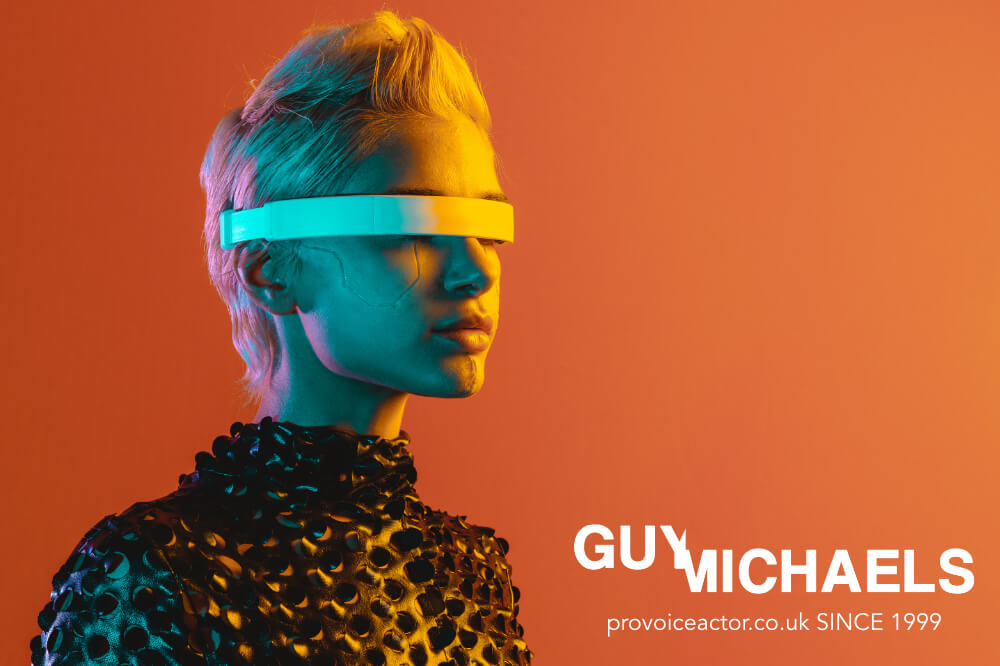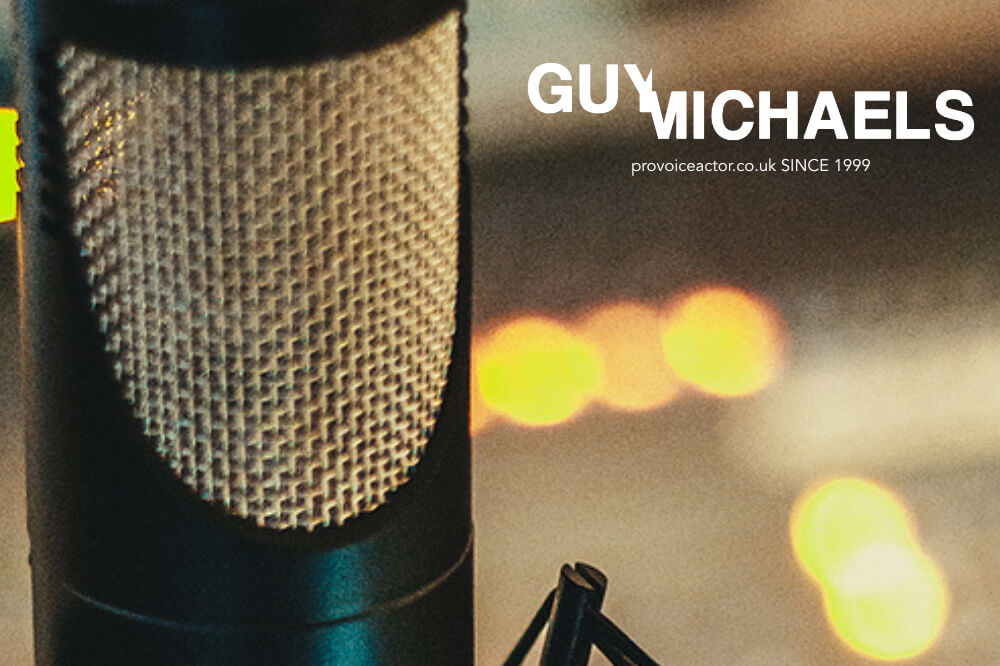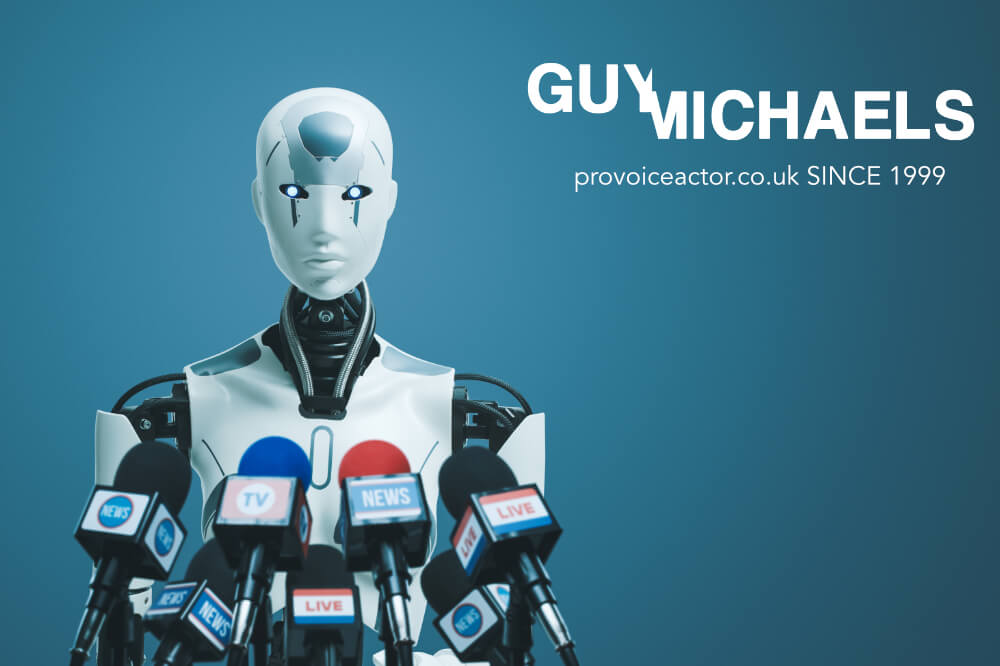
Guy Michaels is a British male voiceover recording in his professional dedicated studio delivering true broadcast quality audio for commercials, narration projects, documentaries, podcasts, corporate jobs and more. Cambridge based with easy access to London (if needed!)
History, Trends, and Opportunities
This article discusses the evolution of the voice over industry in terms of the casting of voice talent and audience perception and needs. The world of voice overs is constantly changing. Thankfully this evolution has given greater balance between roles for the female voice over and the male voice over.

Imagine you’re creating an advert for a new high-performance car. The footage shows a stylish muscle car growling as it skids around dirt roads and gravely wastelands. The wheels spin furiously; clenched around the steering wheel, knuckles turn white; the car speeds off into the distance.
Here’s the question: do you choose a male voice over or a female one?
Male, right? You choose the classic voiceover guy with the deep, resounding voice that’s pure masculinity.
Sometimes, however, it’s not so clear-cut. How about a children’s book reading? Soap advert? Or a nature documentary? The question of a voice actor’s gender reveals some interesting biases and changes in the voiceover industry over the past century, from a male-dominated profession to an increasingly gender-neutral environment.
In this article:
Evolution of the Voiceover Industry
Once upon a time, just like most other sectors, men dominated the voiceover industry. Turn on the ‘wireless’ (aka the radio), and you’d hear either a melodious mid-Atlantic accent or impeccable received pronunciation (RP). But, regardless of the accent, there was one thing in common – the voice was male.
Even cartoon voice overs were male, and who can forget the pithy wartime voiceovers to rouse the troops and population?

But, as the war ended and women began to filter into the workplace, a subtle change began. Female voiceovers became more common. After all, many of the new consumer goods, like washing machines, clothing, or household decoration, were targeted at women. It made sense that it’d be a female voice doing the selling.
By the time the 21st century rolled around, the historical trends of globalisation meant that female voiceovers had become normal – if not sought-after. Platforms and mediums like YouTube, podcasts, and audiobooks rapidly expanded voiceover demand, leading to a greater appreciation and need for different tonal qualities.
The job of the professional voice over artist was changing.

Traditional Gender Roles in Voiceovers
In a world of strict gender roles, it’s little surprise that the voiceover industry mirrors societal expectations. People expect to hear groundbreaking stories read by an authoritative male voiceover, while females’ association with nurturing and housework meant that domestic products, children’s content, or beauty products were the domain of female voice actors.
Ask yourself if you think these gender roles still apply:
For Male Voiceovers:
- Authoritative Roles: Often chosen for narration in documentaries, political ads, and trailers due to the perceived authority of deeper male voices.
- Technical and Informative: Male voices frequently dominated ads for cars, technology, and tools, highlighting expertise and know-how.
- Adventure and Thrill: Action movie trailers, sports advertisements, and video game characters often featured strong, bold male voices.
- Humorous or Goofy Characters: Animation often uses male voices for comedic, exaggerated roles.
For Female Voiceovers:
- Nurturing and Caring Roles: Women’s softer tones were preferred for children’s content, parenting products, and healthcare advertisements.
- Domestic Product Advertisements: Ads targeting household products, cosmetics, and fashion predominantly had female narrators.
- Seductive or Romantic Tones: Fragrance ads, romantic film trailers, or certain music genres might lean towards a sensual female voice.
- Supportive or Secondary Characters: In animations or video games, female voices were often allocated to side characters or roles that played a supporting function.
Changing Perceptions and Roles
Eagle-eared listeners old enough to remember the voiceovers of the 40s, 50s, and 60s will have heard a gradual shift in recent decades. As societal perceptions evolved, so too did the binary gender expectations in the voiceover industry.
Keenly aware of the demands for inclusivity and representation, brands increasingly seek out female voice actors for something other than traditionally ‘feminine’ roles. Think action trailers, tech adverts, or even neutral or universal voice roles.
Elizabeth Daily might voice the sweet, adorable Buttercup from The Powerpuff Girls or be the voice of Babe, but she’s also Tommy Pickles in Rugrats. Meanwhile, Nancy Cartwright is the genius behind Bart Simpson, Nelson Muntz, Ralph Wiggum, and other beloved characters on The Simpsons.
On the other hand, male voice actors are also breaking traditional gender roles. Dan Castellaneta, who gives life to Homer Simpson, and Billy West, the voice behind Philip J. Fry in Futurama, have also played roles that defy traditional gender stereotypes, offering depth, vulnerability, and a broad emotional range.
As a British male voiceover, could I ever play a female-sounding computer or a little girl in an animation? Actually probably not as my focus is not character voices but there are plenty of professional voice actors who are chameleon like in their abilities.
The times they are a changin’.
Factors Influencing Change
Nothing occurs in isolation. The evolution of male voiceover roles results from a confluence of factors – be they societal, cultural, or industry-based. These include:
- Societal Awareness: As society becomes more aware of gender biases and stereotypes, there’s been a drive to challenge and overcome these limitations in many areas, including voiceovers.
- Cultural Shifts: Mainstream culture has a wide influence. Television programmes and films that highlight diverse and unconventional male characters help to challenge traditional views.
- Industry Dynamics: With the growth of content creation worldwide, there’s a rising demand for a range of voices. This growth provides more chances for male voice over artists to explore roles outside of the usual confines.
- #MeToo Movement: This campaign has been pivotal in highlighting issues of gender inequality and misuse of power within the entertainment sector. This has prompted related sectors, such as voiceovers, to reflect and make necessary changes.
- Push for Gender Equality: The ongoing efforts for gender parity in the entertainment world, seen in actions like campaigns for equal pay and better representation, naturally affect voiceover roles, offering diverse opportunities for everyone.
Impact of Technology
Like almost no other industry, voice acting is technology-led. From radio to podcasts, every significant change occurred due to a technological shift – be it the development of microphones to the smartphone. However, one consistency was the reliance on soundproof and treated studios for broadcast quality audio.

As a British male voiceover I run my own dedicated professional recording studio with full production facilities. GET IN TOUCH
No longer! Increasingly affordable, modern digital recording technology and software means the modern voiceover guy does not always need to rely on external professional studios. Just like YouTubers and podcast hosts, he (or she) can record from the comfort of a home studio, sending the recordings effortlessly over the internet.
The Threat of AI Voice Over
Except: there’s another tectonic shift brewing: voice recognition technology and artificial intelligence (AI).
This novel technology has an uncanny ability to mimic human voices. Think of AI assistants like Siri, Alexa, and Cortana, and they’re usually female voices. (Leave it to the behavioural psychologist to wonder why.)

That could threaten the future of male voice over actors. However, AI is, as yet, unable to replicate the subtle emotion, cadence, and depth of a human voice, and we’re starting to hear more male voiceovers for tech platforms as time goes by.
The Rise of Gender-Neutral Roles
Male and female gender norms are on the decline. Consumers and listeners no longer expect a masculine or feminine voice for certain roles. It’s led to some interesting possibilities.
Got a mysterious, enigmatic character in a video game or animation? You might now opt for a voice that keeps the player guessing, adding layers to the narrative. We’re used to ‘Cortana’ in the Halo series and GLaDOS in the ‘Portal’ games being distinctly female. But you can challenge expectations (and even unnerve the player) by casting a male voiceover or digitally altering the voice to be more gender-neutral, emphasising a robot’s or AI’s inhuman characteristics.
In fact, it’s happening in real life: in 2021, Apple announced that Siri would no longer default to female. Users would instead choose between a ‘male’ or ‘female’ voice. Meanwhile, Virtue developed Q to be ‘genderless,’ getting nominated for the Beazley Designs of the Year award.
Forget the generic’ voiceover guy’ – this brave new world presents new challenges and opportunities for male voice over actors. That could be tackling a fashion brand, a children’s book, or a world-famous digital assistant. The possibilities are endless.
Closing Thoughts
Gone are the days of the archetypal ‘voiceover guy,’ thankfully new societal expectations have opened the door for female voice actors to try new roles and step into the shoes of their male counterparts. Far from limiting male voice over opportunities, however, it has led to an equal playing field where anyone can tackle any role.
New challenges from AI and greater competition are keeping voice actors on their toes. But people still want the authenticity and emotion of the real thing.
As a British male voiceover artist, I’m happy to work across genres in a variety of roles.
Get in touch – if you think I can help you as the British male voice over for your next media project.
Read more:
